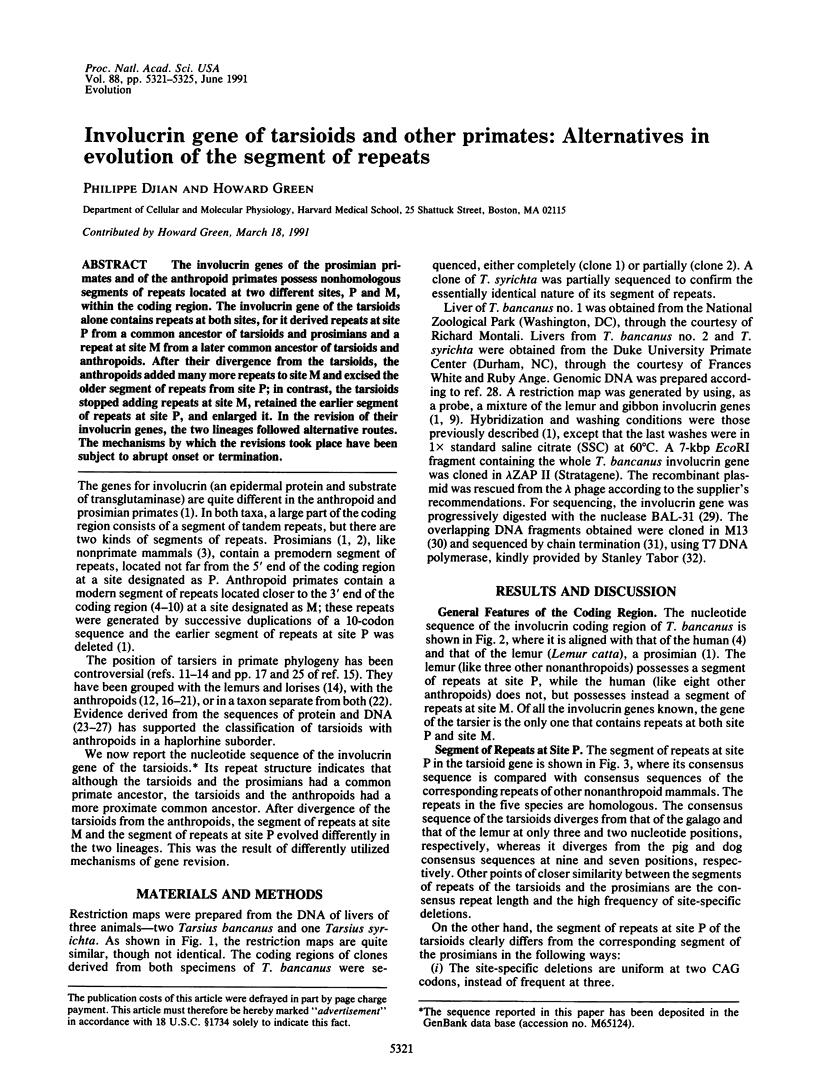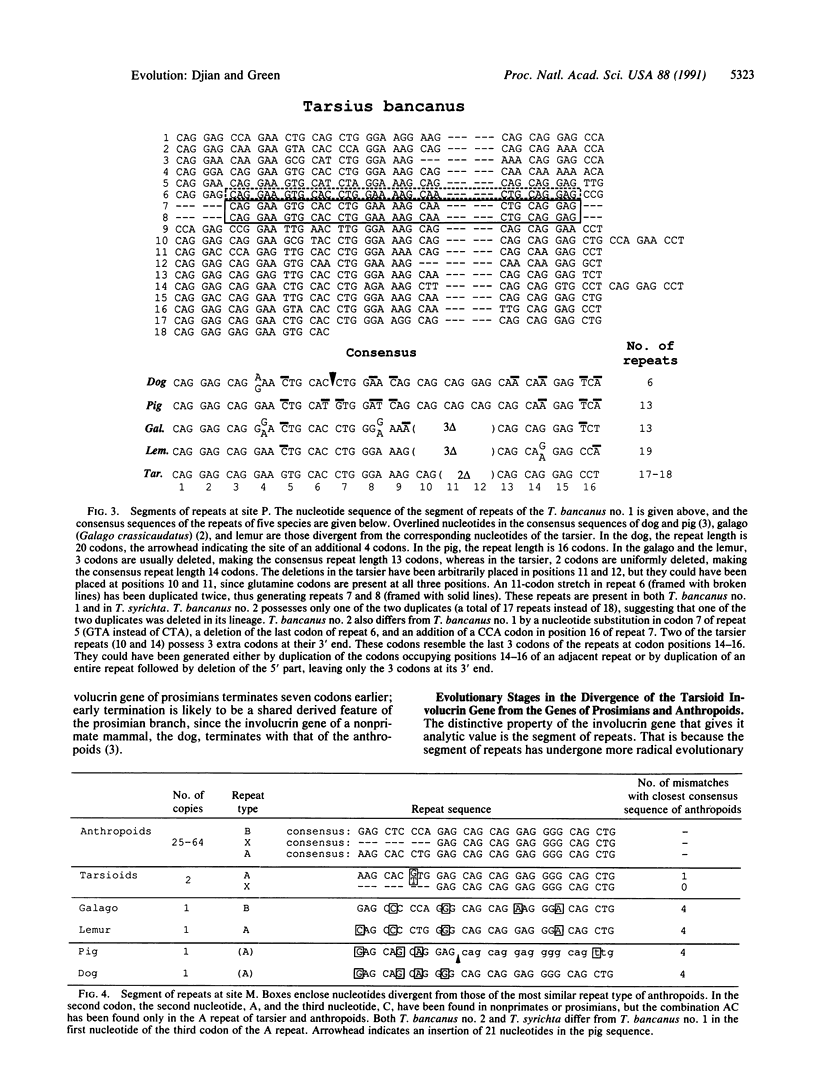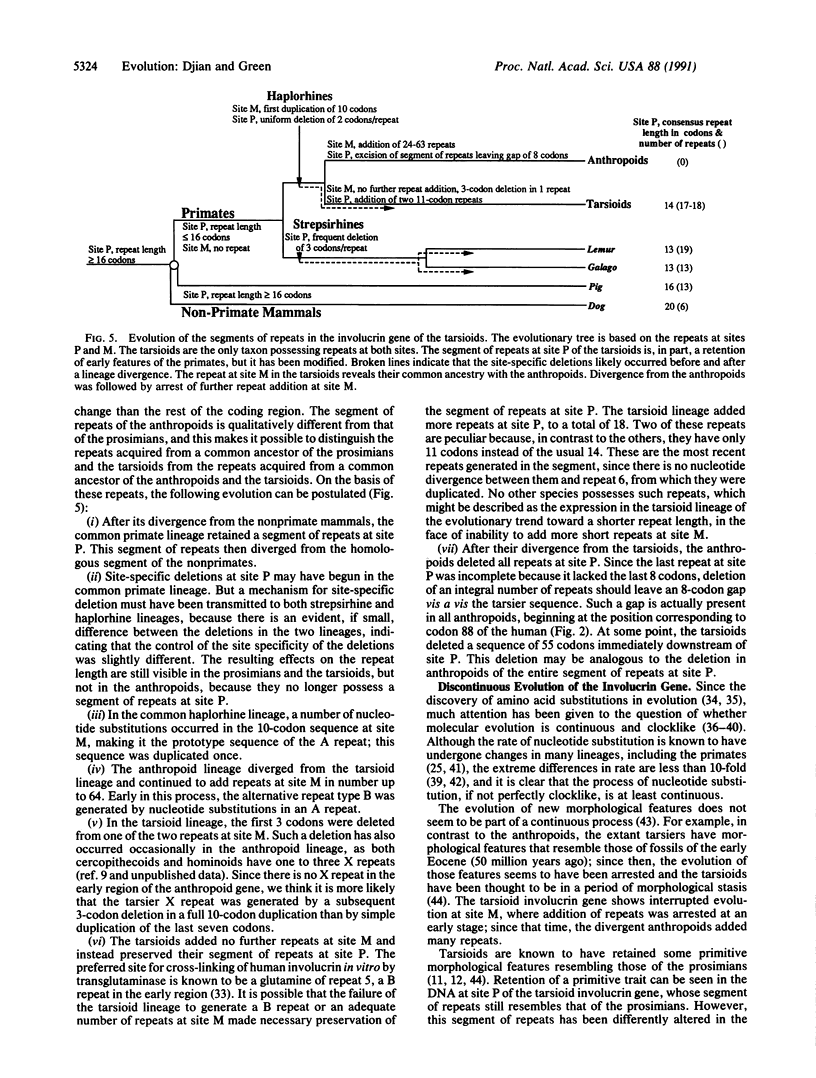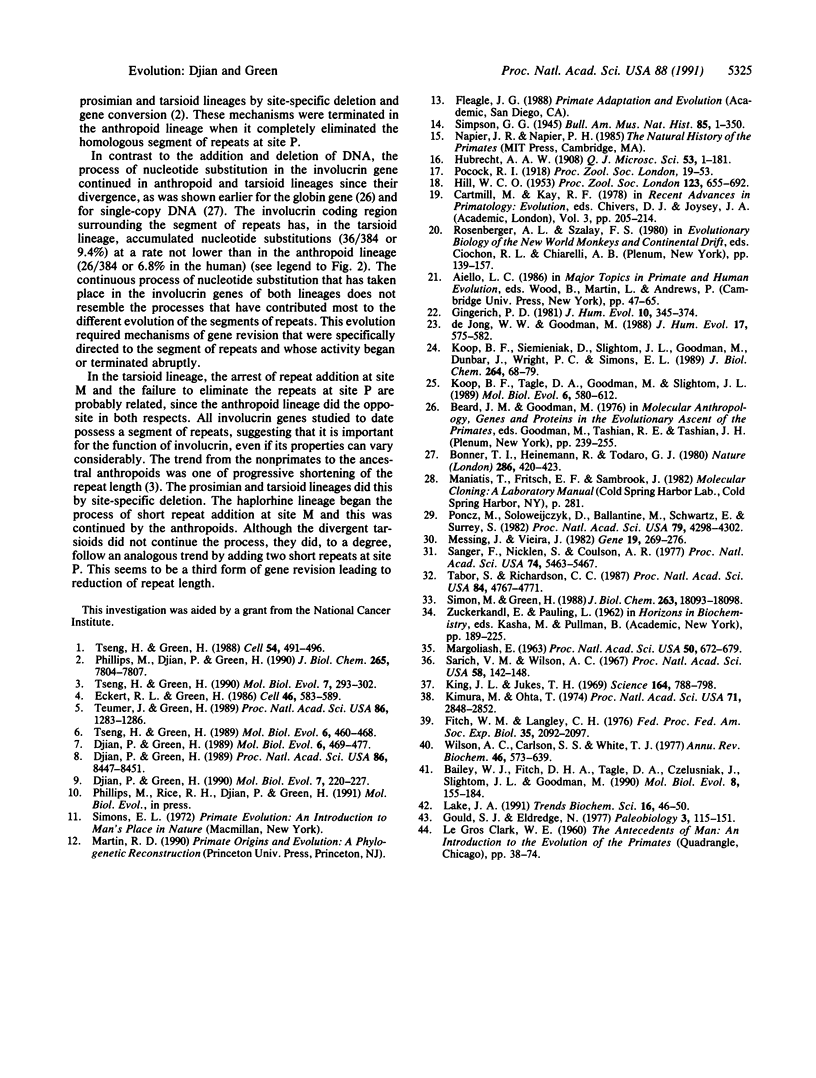Abstract
The involucrin genes of the prosimian primates and of the anthropoid primates possess nonhomologous segments of repeats located at two different sites, P and M, within the coding region. The involucrin gene of the tarsioids alone contains repeats at both sites, for it derived repeats at site P from a common ancestor of tarsioids and prosimians and a repeat at site M from a later common ancestor of tarsioids and anthropoids. After their divergence from the tarsioids, the anthropoids added many more repeats to site M and excised the older segment of repeats from site P; in contrast, the tarsioids stopped adding repeats at site M, retained the earlier segment of repeats at site P, and enlarged it. In the revision of their involucrin genes, the two lineages followed alternative routes. The mechanisms by which the revisions took place have been subject to abrupt onset or termination.
Full text
PDF




Images in this article
Selected References
These references are in PubMed. This may not be the complete list of references from this article.
- Bailey W. J., Fitch D. H., Tagle D. A., Czelusniak J., Slightom J. L., Goodman M. Molecular evolution of the psi eta-globin gene locus: gibbon phylogeny and the hominoid slowdown. Mol Biol Evol. 1991 Mar;8(2):155–184. doi: 10.1093/oxfordjournals.molbev.a040641. [DOI] [PubMed] [Google Scholar]
- Bonner T. I., Heinemann R., Todaro G. J. Evolution of DNA sequences has been retarded in Malagasy primates. Nature. 1980 Jul 24;286(5771):420–423. doi: 10.1038/286420a0. [DOI] [PubMed] [Google Scholar]
- Djian P., Green H. The involucrin gene of the gibbon: the middle region shared by the hominoids. Mol Biol Evol. 1990 May;7(3):220–227. doi: 10.1093/oxfordjournals.molbev.a040601. [DOI] [PubMed] [Google Scholar]
- Djian P., Green H. The involucrin gene of the orangutan: generation of the late region as an evolutionary trend in the hominoids. Mol Biol Evol. 1989 Sep;6(5):469–477. doi: 10.1093/oxfordjournals.molbev.a040570. [DOI] [PubMed] [Google Scholar]
- Djian P., Green H. Vectorial expansion of the involucrin gene and the relatedness of the hominoids. Proc Natl Acad Sci U S A. 1989 Nov;86(21):8447–8451. doi: 10.1073/pnas.86.21.8447. [DOI] [PMC free article] [PubMed] [Google Scholar]
- Eckert R. L., Green H. Structure and evolution of the human involucrin gene. Cell. 1986 Aug 15;46(4):583–589. doi: 10.1016/0092-8674(86)90884-6. [DOI] [PubMed] [Google Scholar]
- Fitch W. M., Langley C. H. Protein evolution and the molecular clock. Fed Proc. 1976 Aug;35(10):2092–2097. [PubMed] [Google Scholar]
- Kimura M., Ohta T. On some principles governing molecular evolution. Proc Natl Acad Sci U S A. 1974 Jul;71(7):2848–2852. doi: 10.1073/pnas.71.7.2848. [DOI] [PMC free article] [PubMed] [Google Scholar]
- King J. L., Jukes T. H. Non-Darwinian evolution. Science. 1969 May 16;164(3881):788–798. doi: 10.1126/science.164.3881.788. [DOI] [PubMed] [Google Scholar]
- Koop B. F., Siemieniak D., Slightom J. L., Goodman M., Dunbar J., Wright P. C., Simons E. L. Tarsius delta- and beta-globin genes: conversions, evolution, and systematic implications. J Biol Chem. 1989 Jan 5;264(1):68–79. [PubMed] [Google Scholar]
- Koop B. F., Tagle D. A., Goodman M., Slightom J. L. A molecular view of primate phylogeny and important systematic and evolutionary questions. Mol Biol Evol. 1989 Nov;6(6):580–612. doi: 10.1093/oxfordjournals.molbev.a040574. [DOI] [PubMed] [Google Scholar]
- Lake J. A. Tracing origins with molecular sequences: metazoan and eukaryotic beginnings. Trends Biochem Sci. 1991 Feb;16(2):46–50. doi: 10.1016/0968-0004(91)90020-v. [DOI] [PubMed] [Google Scholar]
- Messing J., Vieira J. A new pair of M13 vectors for selecting either DNA strand of double-digest restriction fragments. Gene. 1982 Oct;19(3):269–276. doi: 10.1016/0378-1119(82)90016-6. [DOI] [PubMed] [Google Scholar]
- Phillips M., Djian P., Green H. The involucrin gene of the galago. Existence of a correction process acting on its segment of repeats. J Biol Chem. 1990 May 15;265(14):7804–7807. [PubMed] [Google Scholar]
- Poncz M., Solowiejczyk D., Ballantine M., Schwartz E., Surrey S. "Nonrandom" DNA sequence analysis in bacteriophage M13 by the dideoxy chain-termination method. Proc Natl Acad Sci U S A. 1982 Jul;79(14):4298–4302. doi: 10.1073/pnas.79.14.4298. [DOI] [PMC free article] [PubMed] [Google Scholar]
- Sanger F., Nicklen S., Coulson A. R. DNA sequencing with chain-terminating inhibitors. Proc Natl Acad Sci U S A. 1977 Dec;74(12):5463–5467. doi: 10.1073/pnas.74.12.5463. [DOI] [PMC free article] [PubMed] [Google Scholar]
- Sarich V. M., Wilson A. C. Rates of albumin evolution in primates. Proc Natl Acad Sci U S A. 1967 Jul;58(1):142–148. doi: 10.1073/pnas.58.1.142. [DOI] [PMC free article] [PubMed] [Google Scholar]
- Simon M., Green H. The glutamine residues reactive in transglutaminase-catalyzed cross-linking of involucrin. J Biol Chem. 1988 Dec 5;263(34):18093–18098. [PubMed] [Google Scholar]
- Tabor S., Richardson C. C. DNA sequence analysis with a modified bacteriophage T7 DNA polymerase. Proc Natl Acad Sci U S A. 1987 Jul;84(14):4767–4771. doi: 10.1073/pnas.84.14.4767. [DOI] [PMC free article] [PubMed] [Google Scholar]
- Teumer J., Green H. Divergent evolution of part of the involucrin gene in the hominoids: unique intragenic duplications in the gorilla and human. Proc Natl Acad Sci U S A. 1989 Feb;86(4):1283–1286. doi: 10.1073/pnas.86.4.1283. [DOI] [PMC free article] [PubMed] [Google Scholar]
- Tseng H., Green H. Remodeling of the involucrin gene during primate evolution. Cell. 1988 Aug 12;54(4):491–496. doi: 10.1016/0092-8674(88)90070-0. [DOI] [PubMed] [Google Scholar]
- Tseng H., Green H. The involucrin gene of the owl monkey: origin of the early region. Mol Biol Evol. 1989 Sep;6(5):460–468. doi: 10.1093/oxfordjournals.molbev.a040563. [DOI] [PubMed] [Google Scholar]
- Tseng H., Green H. The involucrin genes of pig and dog: comparison of their segments of repeats with those of prosimians and higher primates. Mol Biol Evol. 1990 Jul;7(4):293–302. doi: 10.1093/oxfordjournals.molbev.a040609. [DOI] [PubMed] [Google Scholar]
- Wilson A. C., Carlson S. S., White T. J. Biochemical evolution. Annu Rev Biochem. 1977;46:573–639. doi: 10.1146/annurev.bi.46.070177.003041. [DOI] [PubMed] [Google Scholar]



